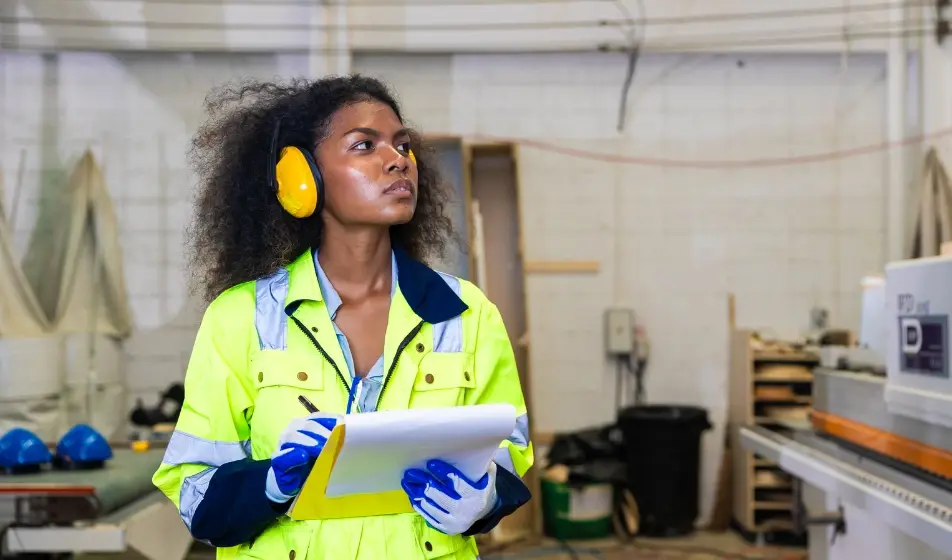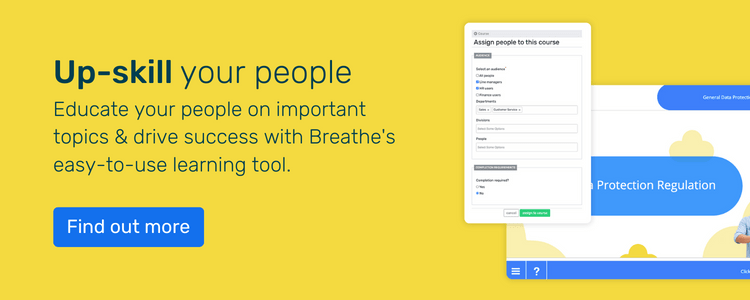As a small business owner, you’ll know that health and safety is incredibly important.
Ignoring health and safety can be costly - both for your people and your business. In fact, a report from the Health and Safety Executive says that the cost of injuries and ill health from current working conditions was estimated at a staggering £21.6 billion. The impact of work-related illness and injury resulted in 33.7 million lost working days.
With that in mind, it’s important to know who’s responsible for what when it comes to upholding health and safety measures in the workplace. For this, it's helpful to turn to health and safety legislation.
According to The Health and Safety at Work Act 1974 it's mostly the employer's responsibility to make sure everyone is safe. This includes anyone on-site, whether that's employees, visitors or the general public.
But it's not just employers who have responsibilities. In fact, there are a number of health and safety requirements that employees also need to be aware of. These include:
-
Taking reasonable care of their own health and safety
-
Co-operating with you (their employer) and following instructions
-
Not putting others in danger
-
Report any hazards, illnesses or injuries
Understanding employer and employee responsibilities
Health and safety at work is a shared responsibility. Employers need to spot potential risks, put the right steps in place and make sure their team knows what’s expected. That means offering the right training, keeping safety policies up to date and making sure equipment is safe and easy to use.
Employees have a role to play too. They need to follow the guidance that’s been set, take part in training and raise any concerns. When everyone plays their part, it’s easier to keep each other safe – and to build a culture that puts people first.
Consequences of ignoring health and safety
When health and safety gets overlooked, it doesn’t just put people at risk – it puts your business at risk too.
Employees who don’t follow procedures can face disciplinary action and risk serious harm to themselves or others. For employers, the consequences can be even more severe – from legal action and hefty fines to damage to reputation and team morale.
Can employees be prosecuted for safety violations?
Yes, they can. While employers carry the main responsibility for workplace safety, employees also have legal duties. If an employee knowingly ignores safety procedures, behaves recklessly, or fails to report a serious risk, they could face legal consequences. In serious cases, this might mean prosecution under health and safety law – especially if their actions lead to harm.
That's why it's so important for everyone to understand their responsibilities and take them seriously. Staying informed, following guidance, and speaking up when something’s not right all play a part in creating a safe, supportive environment for everyone.
But it’s not just about avoiding penalties. A workplace that prioritises safety shows care, builds trust and helps people do their best work. When you put the right support in place, everyone benefits – and your business is stronger for it.
What are employees' health and safety responsibilities?
Employees play a vital part in maintaining a safe and healthy workplace. By being proactive, following the guidance provided, and supporting one another, they can help prevent accidents and create a safer environment for everyone.
Here's a closer look at the key responsibilities employees should be aware of and how they can keep themselves and others safe day to day.
1. Taking reasonable care
Your employees need to actively take care of their own occupational health and safety and avoid doing anything that could compromise it. There's no 'one-size-fits-all' solution for what this looks like – it heavily depends on your workplace and the everyday hazards that come with it.
Here are some examples of personal health and safety responsibilities for different job roles:
- Office administrator: Take extra care with electrical equipment and make sure the employee sits correctly at their desk to avoid back problems.
- Construction worker: Wearing personal protective equipment and clothing to minimise the risk of injury.
- Warehouse operative: Ensure walkways and storage areas are kept clear of obstructions to prevent trips, slips and falls. Use correct lifting techniques and equipment to avoid injuries.
Ultimately, these details will be specific to your organisation and industry, so it's important to think carefully about how this impacts your own employees. The best way to do this is through a workplace risk assessment, in which you identify potential risks and plan a rigorous set of mitigation measures and policies to combat them.
2. Co-operating with their employer
Employees are also required to follow any health and safety arrangements and instructions you provide – and stick to them.
This involves undergoing any training that you send their way and making sure it's done properly, as well as following any rules and regulations that you put in place for the company. This particularly includes any control measures you identify in the risk assessment.
For example, if your in-house health and safety policy requires anyone with hair below shoulder length to tie it up, then it's your employees' responsibility to make sure they do so. The same goes for removing jewellery and ensuring that all protective clothing is worn.
3. Not putting others in danger
While your employees need to be looking after their own health and safety in the workplace, they also need to make sure they're not putting anyone else in danger either. This could include:
- Properly storing equipment
- Cleaning up spills and hazardous substances immediately
- Following safety procedures
- Operating machinery safely
To meet this responsibility, employees should put their training into practice. Getting it wrong could put people at risk.
4. Speaking up if something is wrong
Employees have a responsibility to let you know of any dangers they come across in the workplace so that you can deal with them, such as:
- Seeing a loose wire in a plug socket next to their desk
- Wet floors, uneven surfaces or cluttered corridors
- Protective equipment not being worn around machinery
If an employee sees these issues and fails to report them, they could very easily be at fault. But for that to be the case, you need to have first given them clear guidance for what good health and safety practices at work involve.
Good communication is one of the most powerful tools in keeping people safe. That means encouraging a culture where it's normal to speak up, ask questions and share concerns.
Whether it's raising a potential issue, suggesting improvements or asking for clarity, employees should feel confident discussing health and safety with managers and colleagues.
And it's not just about workplace hazards. If something happens that may affect someone's ability to work, they need to make you aware. This could be physical or mental illness, injury or pregnancy. The responsibility lies with the employee to inform you, so that you're able to make the reasonable adjustments they need or provide them with time off.
When communication is open and honest, it's easier to spot risks early, avoid misunderstandings and keep everyone in the loop. That's how teams stay safe together.
Developing an effective health and safety policy
A clear and practical health and safety policy is the foundation of a safe workplace. It sets out your approach, outlines who’s responsible for what, and helps your team understand how to stay safe at work.
Every health and safety policy should include a few key elements:
-
A general statement of intent – a brief explanation of your commitment to maintaining a safe and healthy work environment.
-
Roles and responsibilities – who’s in charge of what, from senior leadership through to individual employees.
-
Arrangements and procedures – details of how risks will be managed day-to-day, including things like first aid, emergency plans, and how to report a problem.
You’ll also need to carry out regular risk assessments to identify any hazards in your workplace and decide how to control them. These should be documented, reviewed, and updated regularly. Emergency procedures – like fire evacuation plans or accident reporting processes – should also be included and clearly communicated to your team.
By putting a solid policy in place and keeping it up to date, you’re helping protect your people and keeping your business on the right side of the law. It shows you take safety seriously - and that matters to your team, your reputation and your peace of mind.
Support the wellbeing of your team
While health and safety laws generally rest on the employer, that doesn't mean workers are off the hook. For employers, it's important to set clear rules, measures and policies for your employees to follow. But as far as the government guidance is concerned, it's the employee's job to follow the rules once they've been set out.
That's why adequate training is so important. If you can demonstrate that you've done your own due diligence and given employees clear safety measures to follow, there's a good chance you'll be safe if any issue makes it to a tribunal.
At Breathe, our employee training software features a range of courses on essential topics, including health and safety at work. Check out the full module to find out more.
.webp)
Author: Sarah Benstead
Sarah is a Product Marketing Specialist here at Breathe. Always innovating, she loves writing about product releases in an engaging & informative way. When she's not coming up with new ideas, she enjoys long walks with her dog, Clifford.






